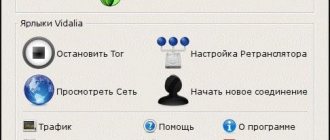Sharing the Internet from your phone can save you during an unexpected power outage, accelerated deadlines and other force majeure. How unpleasant it is to realize that mobile operators are trying to make money from this, moreover, they are disingenuous, showing completely different information in advertising and conditions on the site. For example, this happened with the “Smart Unlimited” tariff from MTS. The operator promises some conditions, but then it turns out that everything is different. However, there is a way to bypass the restriction on MTS Unlimited WiFi distribution! Even several workarounds. By following any of the instructions, you can enable Internet distribution from your phone to your computer and other gadgets, using your smartphone as a wireless WiFi router. Below I will tell you how to distribute Wi-Fi on MTS Unlimited.
How MTS limits Internet distribution
Blocking Internet distribution via Wi-Fi to a laptop and other devices is carried out by monitoring the TTL parameter. The acronym stands for Time To Live and stands for packet lifetime. This term is used in computer networks, which include cellular networks. TTL for smartphones and tablets on Android and iOS is 64, for computers on Windows – 128.
A smartphone connected to the mobile Internet sends parameter 64 to MTS. But if you distribute traffic to another device in modem mode, it will send a TTL reduced by one - 63. In the case of a computer, the value 127 will be sent to the MTS network. The network records the change in TTL in MTS when distributing via Wi-Fi, Bluetooth or cable, stopping the distribution or making it paid. Our task is to change the TTL on devices connected to the distributing smartphone to 65. Then, when passing through the smartphone (it acts as a router), the packet will receive a TTL value of 64. The network recognizes this as the absence of distribution, although in fact there is one.
This is not to say that this is illegal, but such circumvention of restrictions to some extent violates the terms of the contract for communication services. But recognizing the presence of a distribution without TTL is problematic. Therefore, we can easily use this trick to distribute (tetter) unlimited Internet to a computer and other devices.
A SIM card with the Tariffische tariff plan does not work in modems and wireless routers - MTS blocks Internet access.
Removing restrictions using a VPN
Using the VPN function, you can create an additional network on top of the main one. It automatically encrypts data transmission, which does not allow MTS to track how mobile traffic is spent on Tariffishche. With its help, it is possible to distribute Wi-F, on which the provider will not be able to impose restrictions. The VPN section is present by default in any modern device.
To enable the function, just go to the “Settings” tab, select creating a new connection, give it a name and select the encryption method. After this, access to the Internet at Tariffishche will occur through a separate virtual server.
Change TTL
Changing the TTL number on devices connected to a smartphone will help you bypass the restriction on traffic distribution on the Tariffishche tariff from MTS. Let's try to change TTL on Android, devices with iOS and Mac OS, as well as on computers and tablets with Windows.
Adjusting TTL on Android
On the vast majority of Android smartphones and tablets, changing TTL requires root rights (superuser rights). The parameter changes on the receiving device - launch the “TTL Master” application downloaded from Google Play, launch it, enter a new value (65) and click the “Apply” button. We send the device for downloading, connect to the distributing smartphone and try to open something in the browser.
It is also possible to change the TTL through the ES Explorer application. Find the path file proc/sys/net/ipv4/ip_default_ttl, open it with a text editor and change the value to 65. This is done with airplane mode active. After making changes, turn off airplane mode and try connecting to the distribution device.
Another workaround is to change the TTL on the distribution device, but in this case Internet access on it will not be possible.
Replacing TTL on iOS
Owners of smartphones and tablets running iOS are the least fortunate - they need to jailbreak to gain full access to the operating system. Install the "TetherMe" application from the Cydia store (only for jailbroken devices) and use it. Alternatively, you can change the TTL on the dispenser.
Adjusting TTL on Windows
Here everything is much simpler - launch the standard registry editor Regedit and go to the branch “HKEY_LOCAL_MACHINE – SYSTEM – CurrentControlSet – Services – Tcpip – Parameters”. Next, create a DWORD parameter (32 bits) with the name DefaultTTL and the decimal value 65. Save, connect to the distributing smartphone and enjoy unlimited Internet.
Replacing TTL on Mac OS
On Mac OS computers, TTL can be changed in two ways:
- Temporarily (until the PC or laptop is rebooted) - with the command sudo sysctl -w net.inet.ip.ttl=65, executed in the terminal (entering the superuser password);
- Permanently (the changed value is saved even after a reboot) - create the /etc/sysctl.conf file and write the line net.inet.ip.ttl=65 in it. To open the file, use the “TextEdit” application.
Enable tethering on your smartphone and connect to the access point (distributing device). Actions are performed with root rights.
Adjusting TTL on an Android device
Now let's move on to setting up the mobile device itself. To do this, you can use special mobile applications, for example, “TTL Master”. The utility will help you record the numerical value of packets. Follow the algorithm:
- First install the “King Root” program to get root rights when making changes to the system.
- Launch the TTL Master utility.
- The display of the mobile device will show the current value of function 63 or 64.
- Open the settings section and set the desired number – 64.
- Save your changes.
Now the provider will not be able to track your actions and block data transfer. The listed applications may be unofficial and not available on official resources on the Internet. Before downloading, carefully check the file for viruses.
How to bypass MTS restriction on Torrent
The use of torrent resources creates a load on the MTS network, which interferes with other users. If everyone starts downloading torrents, the local segment of the network will collapse and complaints will begin to fall on the operator. The thing is that the mobile Internet is not intended for such purposes. After all, any wireless network will collapse under such a load - this is exactly what happened when the Wi-Max Yota networks were launched in Moscow and St. Petersburg back in 2009. In the evening, due to the numerous torrent users, Internet access was almost impossible.
MTS identifies fans of torrent resources by protocols and characteristic open ports. Our task is to enable traffic encryption and disable support for UDP trackers. Now the network will see undetectable traffic without imposing restrictions on it.
However, MTS has the right to limit the Internet speed for a specific subscriber if they place a significant load on the network.
Changing the encryption in the program
Try enabling encryption in your torrent client. It will allow the user to enter incognito mode and hide their traffic from the operator. Let's look at how to do this using the popular µTorrent program as an example.
To activate the encryption protocol, follow these steps:
- Open µTorrent.
- In the menu, select the “Settings” section.
- Click on “BitTorrent” (in older versions there is no such item, in this case install another torrent client).
- This section contains the “Protocol Encryption” option. By default it is always disabled. Click on the arrow and in the drop-down menu click “Enabled”.
- Here, turn off udp support - the function uses traffic for technical purposes and overloads the channel. The operator can notice this and track the download by IP address. To disable, uncheck the “Enable UDP tracker support” checkbox.
- Click the "Apply" button, then "OK".
Data encryption is not available in all downloadable programs. If you do not find such a function in your torrent client, find another version or application from another developer. Download it and install it. Using the same principle as in the µTorrent example, change the settings.
Here are the settings of another frequently used program - qBittorrent:
- Go to the “BitTorrent” section.
- Set the mode to “Require encryption”.
- Check the “Enable Anonymous Mode” checkbox.
- We uncheck the first three parameters - DHT, PeX and local peer detection.
- Go to the “Connection” section.
- The number of connections must be limited. We set the limit to 50, this is enough for quick downloading, but will not overload the channel.
- It is worth disabling the uTP protocol, change it to TCP.
- Disable the router's UPnP and use a random port.
Save the changes. During setup, you need to disable all file transfers. If the limit is set dynamically on the network, you will need to reboot the router. Now you can try downloading from a torrent.
At what MTS tariffs can you distribute Internet?
Now you know how to distribute the Internet from an MTS phone without restrictions. We change the TTL on the connected devices and use it. In the case of an iPhone, you will have to sacrifice the warranty and jailbreak it. The scheme with this parameter is suitable for the following tariffs, where unlimited Internet is provided:
- “Tariffishche” – unlimited traffic with a subscription fee from 650 rubles/month. The amount of the monthly fee depends on the number of minutes and SMS included in the tariff;
- “Smart Top” – unlimited traffic, 3000 minutes within Russia and 3000 SMS for 1950 rubles/month;
- “ULTRA” – unlimited traffic, 3500 minutes and 3500 SMS within Russia for 2900 rubles/month;
- “Our Smart” – 1500 minutes to all networks, 1500 SMS and unlimited Internet for 1000 rubles/month.
The “For Laptop” tariff allows for free distribution of traffic through a mobile router.
Offers from competitors
- Beeline - there are no suitable tariffs, distribution is paid for unlimited;
- MegaFon – on the tariffs of the “Turn on” line, free and unlimited distribution of traffic is possible. Subscribers also have access to the “Your Internet” tariff for 6 or 12 months with a SIM card in the modem or phone;
- Tinkoff Mobile - paid unlimited distribution for 399 rubles. Unlimited itself costs another 999 rubles;
- Tele2 – distribution without tricks is impossible;
- Iota - distribution without tricks is possible only on tariffs for modems and routers.
On Yota tariffs for smartphones and tablets, traffic distribution is prohibited. Changing the TTL helps, but only partially - the network analyzes the packets and identifies traffic that is typical for Windows and some Windows applications. Here, in addition to changing the TTL, you will have to organize an unlimited VPN connection.
Rate this article
Author
Vyacheslav
For several years he worked in mobile phone stores of two large operators. I understand tariffs well and see all the pitfalls. I love gadgets, especially Android ones.
Latest news from MTS!
From 02/12/2019, the operator provided the opportunity for tariff subscribers to distribute the Internet via Wi-Fi, USB or Bluetooth. Moreover, the transfer of the first 3 GB per month is free. If this limit is exceeded, the service is provided for a fee and amounts to 75 rubles. in a day.
The answer to the question - why you can’t distribute the Internet at Tariffishche is obvious. It is not profitable for a provider to provide unlimited traffic for such a low price. However, you should not immediately refuse the unlimited package. There are many methods for circumventing restrictions in the network space. Enjoy it for your health!
Cost of services
For communication services on three-in-one “All MTS” tariffs, the subscription fee is 690-2490 rubles for residents of Moscow and the Moscow region. The cost depends on the selected option package. For the first month, when switching or connecting to the tariff, the monthly fee is not charged and amounts to zero rubles, but subject to the subscriber paying a minimum amount of 300 rubles. to the SIM card account. The promotion is valid until September 30, 2021.
Expert opinion
Alice
Mobile phone salon employee. Knows everything about the services and tariffs of the mobile operator MTS.
For residents of regions, the price of the tariff is different. For example, the same tariff will cost 550 rubles monthly for the Primorsky Territory, 650 rubles for Sochi, 590 rubles for Yekaterinburg, for St. Petersburg and the Leningrad region. The cost of the All MTS Super tariff will be 690 rubles/month.
When connecting and choosing a tariff, check the price and conditions on the official MTS website by selecting your region of residence.
- Select a region, for example Kaluga region - the city of Kaluga:
- Below you can see the current tariff plans for your region:
The family tariff from MTS includes home Internet and mobile communications, IPTV and mobile TV. The subscription fee is debited automatically by the operator on a monthly basis from a single personal account linked to the mobile phone number, which allows the client to comfortably use all the features of the tariff.
Also read: How to make call details on MTS
Funds must arrive at the subscriber's number no later than 20 days after the invoice is issued to avoid blocking. If there is no money on the date the subscription fee is charged, the operator reserves the right to temporarily suspend access to the services. It will be possible to remove the forced blocking immediately after depositing funds into the account in an amount equal to the cost of the tariff.
Expert opinion
Alice
Mobile phone salon employee. Knows everything about the services and tariffs of the mobile operator MTS.
The contract may be terminated by the operator if the subscriber does not use paid communication services for more than 183 calendar days.
How much does the entire MTS cost in Moscow and the Moscow region?
The convergent tariff simultaneously includes three main services - home Internet, MTS TV 2.0 and mobile communications, which have a single subscription fee. The table below shows the cost of services in Moscow and the Moscow region:
| "All MTS" | “The whole MTS is super” | "All MTS maxi" | "The entire MTS giga" | |
| Subscription fee per month | 0 rub. in the first month/690 rub. | 0 rub. in the first month/990 rub. | 0 rub. in the first month/1290 rub. | 0 rub. in the first month/2490 rub. |
| Discount on monthly fee | From 40% on the entire package of services | |||
| Cellular tariff – outgoing calls | 500 minutes* | 1000 minutes* | 2000 minutes* | 5000 minutes* |
| Mobile Internet | 15 GB free** | Unlimited | ||
| Incoming calls and SMS | For free | |||
| Outgoing SMS | 100 SMS within the package, 2 rubles - for one text message in addition to the package in Moscow and the region. | |||
| Outgoing/incoming mms | 9.9 RUR/0 RUR*** | |||
| Home Internet | Unlimited at speeds up to 200 Mbit/s | Unlimited at speeds up to 300 Mbit/s | Unlimited at speeds up to 500 Mbit/s | Unlimited at speeds up to 1 Gbps |
| Digital TV | No | 140 channels | ||
| Additional packages of channels and services | No | For a fee**** | ||
* Within the package, calls in your home region are not charged. When it is exhausted, a minute of conversation is 3 rubles per minute.
** After exhaustion of the 15 GB package included in the tariff offer, the subscriber is automatically connected to additional Internet packages until the date the subscription fee is charged. The volume of each of them is 500 MB, and the cost is 95 rubles. No more than 15 such packages can be connected monthly. After they are exhausted, the subscriber is given the right to activate the “Turbo button”. The packages are valid throughout Russia.
Expert opinion
Alice
Mobile phone salon employee. Knows everything about the services and tariffs of the mobile operator MTS.
To refuse automatic activation of additional Internet, you need to dial the following combination from your device: *111*936# . In case of refusal of this service when the main package is exhausted, the subscriber can use the “Turbo button” from 100 MB to 20 GB. You can connect it in your personal account in the services section or through the My MTS application.
*** Sending MMS is possible if available on the number. For sending and receiving such messages abroad, you will be charged according to the international roaming tariff plan.
**** The list of additional services for home MTS TV includes:
- personal TV;
- online cinemas Start and ivi;
- other information services;
- repeat-TV;
- multiroom – connection to up to 3 TVs in an apartment;
- TV broadcast recording;
- TV break.
How to use a tariff on several numbers
If you and your loved ones use “All MTS”, then you can team up and share packages by connecting. The only condition for this is binding to a specific region. This means that a user of a Moscow SIM card can join a group with subscribers in Moscow and the region. In this case, numbers can be registered to different subscribers.
Expert opinion
Alice
Mobile phone salon employee. Knows everything about the services and tariffs of the mobile operator MTS.
Due to the introduction of the “WE MTS” tariff plan, the general package service is no longer available on the “All MTS” tariff; read more about the new family tariff at the link at the beginning of the article.
To start using tariff options on several numbers, you need to create a group of participants and invite them to use a common package of services. The group owner can allocate and manage limits, as well as add and delete numbers through the personal account on the operator’s website, through the “My MTS” application or by dialing the command *434*1*phone number, starting from 7# . Participants can use service packages both at home and while traveling around Russia under the conditions connected to the main number.
Additional features and discounts
Among the additional features and discounts on the “All MTS” trio tariff offer are:
- unlimited access to the ivi service. The first month is free, from the second – 399 rubles/month;
- free use of the iCloud file storage service for one month, starting from the second - the cost depends on the storage volume chosen by the subscriber;
- free mobile TV;
- discount “For our own”. A subscriber connected to a family tariff can receive a monthly discount of up to 40% on cellular fees for 1-5 numbers simultaneously. You can activate the offer by command *919*1*7ХХХХХХХХХХ# or by creating a group in your personal account or application. When creating a group, a one-time payment of 100 rubles will be charged. The discount will start working as soon as the recipient accepts the invitation. The subscription fee will decrease from the second month of use;
exception rates:
| corporate rates; | "MTS Connect"; |
| tariff plans without subscription plans; | "For Laptop"; |
| Smart mini; | "For Auto"; |
| Smart light; | "Smart device"; |
| "MTS Tablet"; | "Cool"; |
| "MTS Connect"; | "Pro"; |
| tariffs of the “All MTS” line; | "Regional"; |
| "For Tablet"; | "MTS Tablet"; |
- 10% discount on the monthly fee for a tariff for a period of 6 months when connecting according to a threshold, which allows you to automatically top up your account when you reach a certain amount or on a specific date;
- cashback for purchases when using the MTS Cashback service. You can spend it on communication services and on purchases in MTS stores.
Limits and restrictions
When traveling, the mobile Internet often blocks sites or does not follow links. This is due to the fact that when leaving the home region, the first 500 megabytes are provided at maximum speed, and further traffic is provided at 128 kilobits per second. The speed limit will return to normal only after the expiration of the daily period. If large files are downloaded, a similar situation occurs.
In the changes that indicate the possibility of distributing the Internet, we are talking only about the home area. The operator has established a ban on the distribution of mobile Internet to other mobile devices and computers “outside the home.” In the region where the SIM card was issued, the subscriber is allowed to transfer no more than 3 gigabytes during the reporting period, which is a month.











